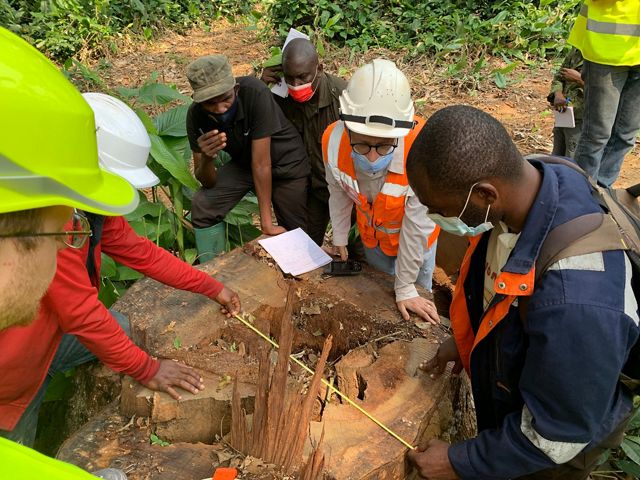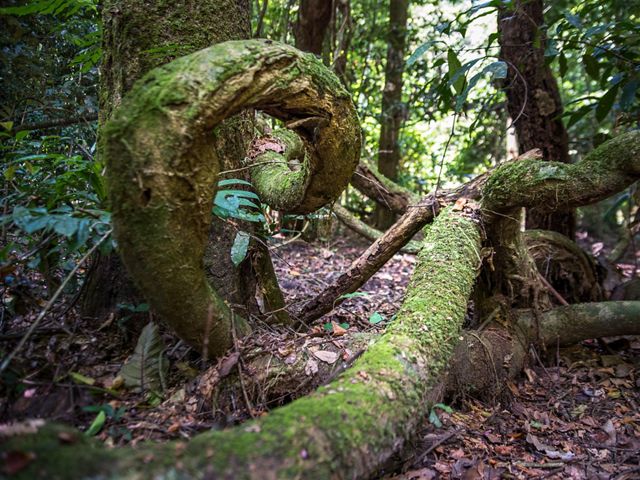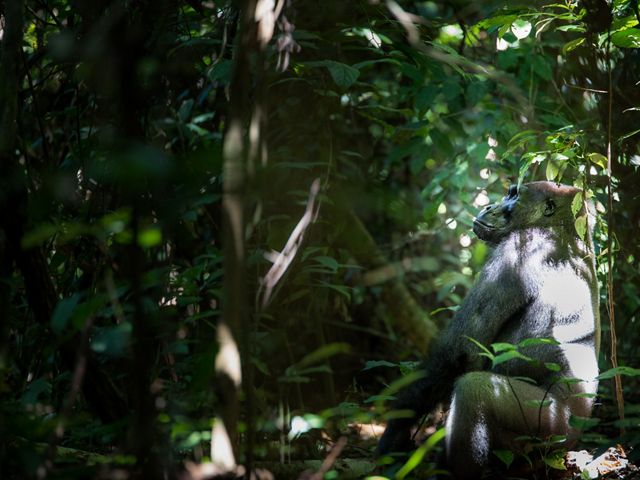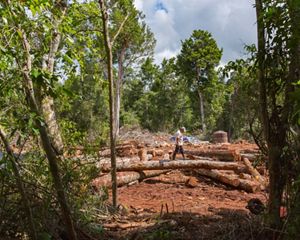Reducing Logging Impacts in the Congo Basin
The Congo Basin is the world’s largest carbon sink. Lower-impact forestry methods used here can have a significant impact on global climate outcomes.
The tracks were fresh in the mud. A leopard had walked across the logging access road between dusk and dawn. And it wasn’t the first animal sighting of the week—forest elephants and western lowland gorillas carried out their daily routines in the forest just as the loggers carried out theirs. Stingless sweat bees made their presence known, too, congregating by the hundreds on any exposed skin perspiring in the midday sun.
The animals provided a wild reminder that a sustainably managed forest is a healthy forest both before logging begins and after logging ends.
This was the experience of Peter Ellis and Ethan Belair, two members of TNC’s global Natural Climate Solutions Science team, who traveled to Republic of the Congo in 2022 to train a group of forest technicians, government officials, and concession staff on the use of a protocol for estimating carbon emissions from logging, and ways to reduce those emissions. Now, for the first time ever, the scientific community has baseline data that will accurately quantify the logging impacts in northern Congo.


The Benefits of RIL-C
Over the past 15 years, TNC has developed an innovative new conservation program called reduced impact logging for climate (RIL-C), a series of best practices for selective logging that allows forest managers to maintain timber harvests while cutting carbon emissions by up to 50 percent. RIL-C can represent a critical change in tropical forest management, given that on average, for every 1 ton of wood extracted from a forest, six tons of wood is lost from collateral damage and waste. Meanwhile, the vast majority of trees are intentionally left to maintain a healthy forest, but their growth and survival can be hampered by various types of collateral damage from timber harvesting equipment.
Basic changes to the ways trees are cut down and removed from the forest can have a huge impact on overall emissions. For example, trained tree-fellers can control the direction of felling to avoid damage to adjacent trees and the carbon emissions that result from another tree's injury or death.
The roads created for machinery can also often be improved. Many corridors are cut extra wide so that the sun can dry out impassable mud during the rainy season. By contrast, narrower roads that are oriented east-west, or used only in drier seasons, can still get sufficient sunlight and leave more healthy trees standing.
The felling and subsequent abandonment of hollow trees, which have a reduced commercial value but provide essential wildlife habitat, is another element of collateral damage that can be avoided. In addition, cutting hollow trees can also be extremely dangerous to the tree feller because these trees will often fall in unexpected directions. In this way, RIL-C not only saves carbon, but lives too; tropical loggers have one of the most dangerous jobs on Earth, with one of nine loggers suffering life-threatening injuries during their career. By checking for hollowness before cutting a tree, fellers can avoid unnecessary hazards and leave the tree alive and standing for wildlife.

Quote: Peter Ellis
The rapid growth of climate financing allows us to actually get the work done to manage forests sustainably. In the conservation world, rarely do you get that kind of opportunity paired with the resources to realize it.
Access to Carbon Financing
Many forest managers in the Congo Basin are interested in applying RIL-C on their forests. Groups that do implement RIL-C practices can reduce their carbon emissions and measure these improvements against a baseline, enabling them access to carbon financing.
The government of Republic of the Congo and some large logging concessions are interested in using RIL-C to keep more carbon in their forests and generate voluntary carbon credits. TNC will assist these stakeholders in developing plans tailored to the region to maximize the amount of carbon reductions.
“Loggers need to be our allies in this fight to avert the climate and biodiversity crises,” Peter said. “If managed forests, which constitute more than a quarter of forests worldwide, stopped being managed for timber, they would be left vulnerable to much more destructive forms of land use like oil palm plantations, which replace sustainably logged forests with a desert of one species, with very little biodiversity and much less carbon."
"Not to mention that we’d have to go looking elsewhere for wood, which, compared to alternatives like plastic, cement, and steel, is much more sustainable and low-carbon,” Peter added.

TNC's History in the Congo Basin
The Congo Basin region spans across six countries in Central Africa—Cameroon, Central African Republic, Democratic Republic of the Congo, Republic of the Congo, Equatorial Guinea, and Gabon. As the second-largest tropical forest in the world, it's immensely valuable in the fight against climate change, for wildlife populations, and for the future of the planet.
TNC has been working in Gabon for the last decade, bringing in science and support to help the country reach its vision of protecting 30 percent of its land, ocean, and freshwater habitat by 2030. In December 2022, Gabon stated its intent to implement this ambitious goal in collaboration with The Nature Conservancy, using an approach called Project Finance for Permanence (PFP), which establishes a broad coalition to achieve conservation at a significant scale.
By tapping into TNC's global network of forestry and carbon experts, we are able to greatly expand conservation outcomes across this critically important basin, thereby strengthening and expanding TNC’s impact through partnership.
“I feel truly honored and energized to work on RIL-C, collaborating with the TNC Africa team, the Congolese and Gabonese governments, and concessionaires together," Peter said. "We all share a vision for sustainably managed, carbon-dense, vibrant forests for the future. But there’s more work to do, and it’s going to require lots of stakeholder engagement and honest discussions about benefit-sharing. I’m convinced we can get it done, but we don’t have much time."



